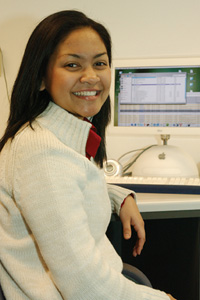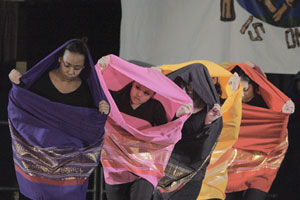 |
|
||
|
|||
University remains a top choice among international students
By Jessica Ullian
|
|
|
|
Hana Azman (CAS’04) came to the University from Malaysia because of the diversity on campus. “BU was a natural choice,” she says. Photo by Vernon Doucette |
|
International students attending college in the United States face an increasingly long — and increasingly exhaustive — list of federal regulations and guidelines. Visas are harder to obtain, Department of Homeland Security requirements change frequently, and many observers question whether some U.S. government officials want foreign exchange visitors at all. It’s no wonder, education researchers say, that the number of international students enrolled in American universities dropped by 2.4 percent last year — the first decrease noted by the Institute of International Education’s annual Open Doors study since 1972.
Boston University, however, is bucking the trend. International enrollment has remained steady, and last year the University retained its long-held place as the top institution for foreign and exchange students in Massachusetts and throughout New England. But the students and administrators involved in BU’s international community say that in this case, it’s not surprising that the University is out of step with the rest of the country. While many undergraduates here have faced obstacles in pursuing an American education, ranging from delayed visas to concerned parents, the University’s strong reputation overseas — and its abundant resources on campus — proved a powerful draw.
“BU was a natural choice, as it is one of the most diverse universities in the United States,” says Hana Azman (CAS’04), who came to the University from Kuala Lumpur, Malaysia, and currently works as a researcher at Sargent College of Health and Rehabilitation Sciences. “When I came, 120 foreign countries were represented at BU itself. I learned a lot about other cultures and respecting and tolerating other people’s opinions.”
The number of countries sending students to the University has grown since Azman arrived in 2000, to approximately 145, as has the number of international students and scholars. There are currently 4,518 students from other countries enrolled, and an additional 1,080 scholars who have come from abroad for research. Nationally, BU has the eighth-largest international population of any major university — a position it has held for at least a decade, according to Urbain DeWinter, associate provost for international programs.
“This is not something BU is new at,” he says. “The international character of the University is very well known, through a long tradition of enrollment and mobility in both directions. All of that helps significantly in times like these.”
|
|
Members of the Filipino Student Association performing a traditional dance at The World Is One, a cultural event that took place last March. There are more than 40 cultural and international clubs affiliated with the Student Activities Office. Photo by Kalman Zabarsky |
|
The Open Doors study cited several factors contributing to the decline in international enrollment: difficulty in obtaining student visas, rising U.S. tuition costs, and concerns about American attitudes toward foreign students. The University’s International Students and Scholars Office is able to significantly curb the bureaucracy and facilitate the transition to life in this country. The office deals with all prospective and incoming foreign students, communicating with them well before their arrival at BU and then ensuring that they are aware of all the regulations and requirements governing their stay here. “We’ve made a very concentrated effort to communicate with our international student and scholar population,” says Jeanne Kelley, the ISSO director. “I think for the most part, our students have been very gracious in accepting some of the new requirements. We’ve done as much as we can to make it somewhat transparent for them.”
The latest challenge has been implementing the Student and Exchange Visitor Information System, the federal database that tracks foreign students in the United States. Working with University Information Systems, DeWinter says, ISSO staff members have been able to put the program into operation smoothly. “They really are experts in all the federal requirements,” he says.
Foreign students’ anxiety about American attitudes is slightly more complex — many international students at BU say that obtaining a visa was the least of the challenges they faced. Azman, a Muslim, knows several people whose families asked them to return home after September 11. Razan Alzayani (COM’07), who grew up in Abu Dhabi in the United Arab Emirates, says that “it took a lot” to convince her parents to send her to an American university. And Bilal Bilici (CAS’06), the head of the student-run International Students Consortium, says that his experiences beyond the University’s borders have been “harder and harsher.”
“For my high school I had to get a visa, which took a week, but this was before 9/11,” says Bilici, who is from Adana, Turkey, but attended an American high school as well. “When I had to get a visa for college, it took a month, because I had to have an interview and prepare paper documents for the U.S. Embassy. They question foreigners more, and I feel like foreigners are treated as second-class citizens.”
Their apprehension about bias against international students, however, is precisely what makes BU so appealing, students say. The city itself, long considered one of the nation’s more European-style municipalities, plays a major role in welcoming students, offering an exciting and varied social and cultural scene. The American university system is also key for many undergraduates, who enjoy the academic flexibility that allows them to explore a variety of subjects instead of choosing a career path before entering college.
Above all, as DeWinter says, BU’s history of diversity breeds more diversity. International students are generally aware of the school’s reputation long before they arrive in Boston, thanks to the success stories shared by international alumni. And when their college career actually begins, they find a wide array of organizations intended to serve their interests — such as the 46 student cultural clubs, the ISSO, and the International Admissions Office. In addition, they receive significant assistance from University administrators — Bilici points to Dean of Students Kenneth Elmore and Thurman Center Director Katherine J. Kennedy as key supporters of the International Students Consortium.
BU is not immune to the difficulties that other institutions face when dealing with international enrollment — DeWinter says there have been a few delayed visas, and a definite increase in paperwork for the ISSO and related offices. But as the process is continually refined, the burden on the students themselves is lifted, leaving more opportunities for them to join clubs, conduct research, or simply enjoy their new surroundings. “Our sense is that our students are very comfortable here, academically and socially,” DeWinter says. “And therefore, they keep coming.”
![]()
19
November 2004
Boston University
Office of University Relations

